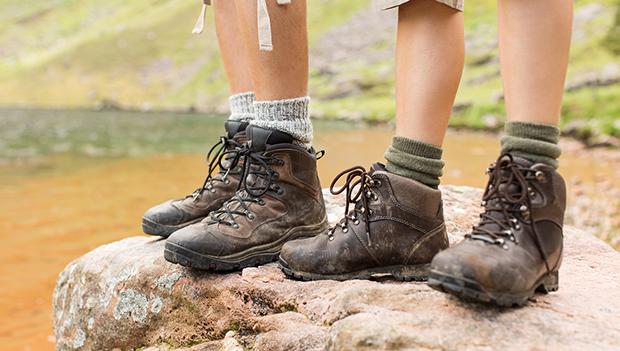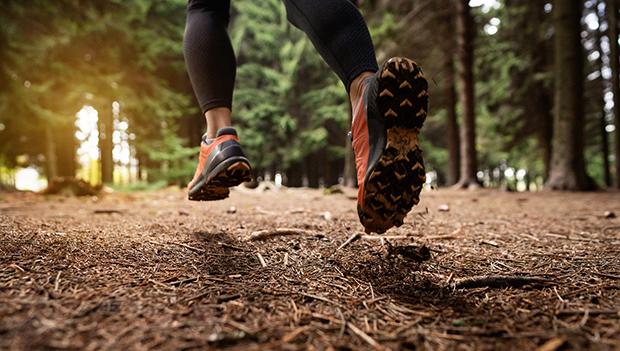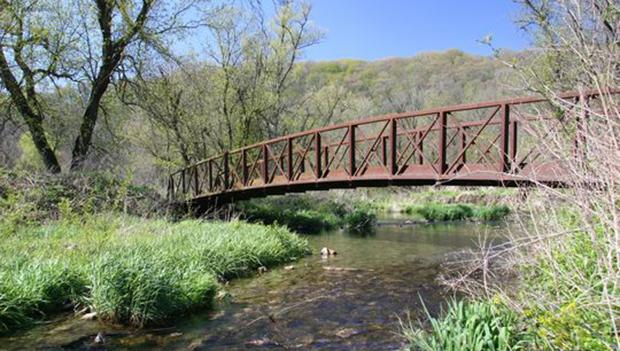How to Choose Summer Hiking Socks & Shoes

Summer hiking conditions require a different set of gear than hiking in cooler weather does. That rule of thumb goes all the way down to your feet. The right summer hiking socks and summer hiking shoes will protect your feet and keep you cool. Below we go over different types of summer hiking socks and summer hiking shoes for easy, moderate, and advanced hiking, with some camping trip suggestions too.
Recommended: 7 Unforgettable Summer Hikes and What to Bring
Protecting Your Feet
First and foremost, you need to protect your feet during your summer hikes. Here are considerations for protecting your feet with the right summer hiking shoes and summer hiking socks.
Shoes
The type of ankle support of your shoe, as well as the rigidity of the footbed, are of top importance when it comes to finding shoes to protect the feet.
A hiking boot in a mid-cut or high-cut style will provide ankle support for those who need it, versus a low-cut hiking shoe that doesn’t provide any support. Generally, hiking boots are better for longer trips, while hiking shoes are suitable for day hikes.
The stiffness - and its opposite, flexibility - of the shoe is determined by the midsoles, shanks, and plates. A stiffer a shoe is, generally, the better it’ll be for rocky or technical terrain, while a more flexible shoe is usually ideal for easy terrain like soft, packed earth.
While guidelines on choosing hiking boot styles are helpful, ultimately deciding on the ankle height and stiffness of a shoe comes down to what feels good on your feet in summer conditions. Remember, the added ankle support translates to more coverage and therefore less ventilation.
Socks
Much like the shoe height, sock height is an important foot protection consideration. Plan on wearing socks that are at least slightly higher than your shoes to protect against skin-to-shoe abrasion. Crew and knee-high socks that come well above the tops of your shoe can also protect the bottom portion of your legs from scrapes on the trail but remember that the extra coverage also means extra warmth.

Recommended: Summer Hiking Clothes - What Should You Wear?
Keeping Your Feet Cool
It goes without saying that you’ll not only want your feet protected, but you’ll also want to keep as cool as possible in hot summer hiking conditions. When it comes to summer hiking shoes and summer hiking socks, here are some tips on choosing the right ones to stay cool and comfortable.
Shoes
The key to keeping your feet cool in hot conditions is wearing breathable hiking shoes. As you might guess, water-resistance and breathability are opposites. Water-resistant materials create an impermeable layer that both water and air cannot easily pass through. For this reason, grab summer hiking shoes without waterproofing (unless you’re hiking in cool, wet summer hiking conditions).
Socks
Sock cushioning can help protect your feet from abrasions and make you more comfortable on the trail; however, more cushioning also means more warmth. Summer hiking socks with no or light cushioning are best for the hot weather, versus medium or heavy cushioning, which should be reserved for cool or cold weather.
In addition to the sock thickness, the sock material also affects your foot temperature. In cold and hot weather, wool remains arguably the best sock material.
Miraculously, the same merino wool fibers that maintain warmth in the cold also keep you cool in the heat. This is through the process of evaporative cooling whereby the wool fibers act as wicks to pull moisture from your skin. Merino wool helps to regulate body temperature and is a natural antimicrobial that eliminates smells better than synthetic fabrics.
Hot Tip: Apex Club members get a special discount on rugged, comfortable Cloudline socks made with Merino wool that have a lifetime guarantee.
Recommended: 9 Mountain Peaks to Hike Before Summer Is Over
Choosing the Right Summer Hiking Shoes & Socks Based on Hike Difficulty
The ideas about protecting your feet and staying cool apply to any type of hike, but certain considerations should be made when choosing summer hiking shoes and summer hiking socks based on trail difficulty.
Easy Hikes To Test Your New Gear
An easy day hike means you can grab summer hiking shoes or trail running shoes and thinner summer hiking socks. This will give your feet the breathability they deserve on a hot day.
Not sure where to go on an easy day hike?
Most state parks have plenty of easy hiking trails, such as at George Washington Campground in Rhode Island. A stand-out easy hike there is the North-South Trail. This 8-mile hike has only 554 feet of elevation gain and is an in-and-out hike where you’re unlikely to see many, if any, other hikers. It takes less than 3 hours to complete.
Make it an overnight camping trip by staying at the campground, located on the shores of Bowdish Reservoir.

Moderate Hikes To Test Gear
A hike designated as moderate may have steeper sections or more technical portions. Your summer hike on a moderate trail should be fine with hiking shoes or trail runners but may require extra traction if it is rocky. Ankle support may be appropriate for people carrying heavy packs or anyone who has ankle problems. Be sure to grab a pair of summer hiking socks that hold up to the rigors of the trail, likely a sock with some cushioning, at least along the footbed.
Where can you do a moderate hike?
Plenty of state parks have moderate hiking trails, like at Yellow River State Forest in Iowa. The park is a perfect place to explore some of Iowa's best hiking trails. Located in northeast Iowa, this park consists largely of hardwood and coniferous forest. There are well-managed camping areas, equestrian accommodations, fishing, hunting, and over 45 miles of multi-use trails for hiking or horseback riding (and cross-country skiing and snowmobiling during the cold winter months). A number of great moderate hikes can be found there, including the Paint Creek Unit Loop at 13.5 miles in length and 1,653 feet of elevation gain. The northern sections are steep and more difficult, and the southern sections are much easier.
Make it a camping trip and book a campsite

Recommended: Cool Down: Secret Natural Swimming Holes
Difficult Hikes
You will know a difficult hike when you encounter it.
Difficult hikes are usually characterized by considerable elevation gains, technical hiking sections, rocky or crumbling trails, and possibly some rock scrambling. For a difficult hike, find out what features make the hike difficult in advance and plan accordingly; this includes choosing footwear.
Typically, you will want more aggressive shoe traction for a difficult hike. Also, if the hike takes you more than one day, or you’re carrying heavy gear, consider wearing hiking boots with ankle support. And of course, always make sure you grab the right summer hiking socks with at least some cushioning to protect your feet from abrasions.
Looking to go on a difficult hike well worth the challenge?
Denali State Park in Alaska is a hiker’s dream, and there are plenty of difficult hikes to explore the area. One of the most popular hikes is the Kesugi Ridge Trail, considered to be one of the most beautiful trails in North America. Coming in at just over 29 miles long, and with nearly 6,000 feet of elevation gain, this multi-day trail takes you through some of the most scenic regions of Alaska.

Are you ready for your adventure? Plan your camping trip!